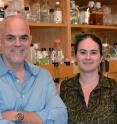TSRI scientists uncover surprising mechanism behind antibiotic-resistant bacteria
Every year, more strains of bacteria develop resistance to the antibiotics we use to treat deadly infections. At The Scripps Research Institute (TSRI) scientists have been working to develop new forms of these drugs, including an antibiotic called arylomycin--but tests have shown that it is possible for bacteria to become resistant to arylomycin, too. Now, scientists at TSRI have discovered that the important human pathogen Staphylococcus aureus, develops resistance to this drug by "switching on" a previously uncharacterized set of genes.
"This explains why antibiotic resistance rates in some bacteria are higher than in others," said TSRI Professor Floyd Romesberg, senior author of the new study. "Resistance depends on this little set of genes that no one knew could contribute to tolerating the arylomycins."
These findings were published this week by the journal mBio.
The Not-So-Essential Protein
Arylomycin antibiotics usually stop bacteria from growing by inhibiting a protein called Type I signal peptidase (SPase), long known as an "essential" protein because scientists thought bacteria could not live without it.
SPase's job is to clip peptide sequences off proteins as the proteins pass from the inside of a cell to the outside to perform functions such as nutrient acquisition. Without this cleaving of the peptide "postal codes," these crucial proteins cannot reach the outside of the cell and instead accumulate in the membrane and the bacterium dies.
At least, that's what scientists thought until studies in the Romesberg lab at TSRI showed that some bacteria survived even when an arylomycin targeted and inhibited SPase. To the researchers' surprise, they found that S. aureus could survive after they deleted the gene to produce SPase altogether.
"We did not believe it," said Romesberg. "No one would have believed SPase was not essential. If you take the wheels off a car--it's not going to drive."
Their next step was to figure out how S. aureus survived without SPase.
"There had to be an answer," said Arryn Craney, a TSRI research associate and first author of the new study.
Unlocking Resistance
Using DNA sequencing technology, the researchers identified a group of genes that work together to fill in for SPase.
They found that, in the absence of SPase, a protein called AyrR switches these genes on to produce proteins called AyrA and AyrBC, which can also cleave off the peptide postal-code sequences. The scientists believe this work-around may have evolved to help bacteria at times when protein secretion levels are high and SPase can't do the job alone.
"We took it for granted that we knew all the steps of protein secretion," said Craney. "Now we've found a way to bypass SPase."
Romesberg said this discovery shows the built-in redundancies that help bacteria survive in many environments. He said the next step in this research is to figure out how the AyrA- and AyrBC-producing genes are switched on in the first place.
"Trafficking proteins through a cell is also very important for human cells," said Romesberg. "All forms of life have to secrete proteins, so discovering this new step in protein secretion has important implications."
Source: Scripps Research Institute
Articles on the same topic
- A paradigm shift in multidrug resistanceThu, 20 Aug 2015, 18:06:41 UTC
- Biologist investigates how gene-swapping bacteria evade antibioticsThu, 20 Aug 2015, 17:05:31 UTC
Other sources
- Paradigm shift in multidrug resistancefrom Science DailyThu, 20 Aug 2015, 19:30:05 UTC
- Scientists uncover surprising mechanism behind antibiotic-resistant bacteriafrom Science DailyThu, 20 Aug 2015, 17:00:10 UTC
- Scientists uncover surprising mechanism behind antibiotic-resistant bacteriafrom PhysorgThu, 20 Aug 2015, 16:30:38 UTC
- Biologist Investigates How Gene-Swapping Bacteria Evade Antibioticsfrom Newswise - ScinewsWed, 19 Aug 2015, 18:00:05 UTC
- Biologist investigates how gene-swapping bacteria evade antibioticsfrom PhysorgMon, 17 Aug 2015, 14:00:42 UTC
